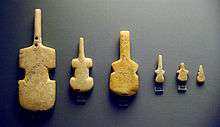Grotta-Pelos culture

Violin-shaped Grotta-Pelos figurines.
Lidded container with herringbone pattern.
The Grotta-Pelos culture (Greek: Γρόττα-Πηλός) refers to a "cultural" dating system used for part of the early Bronze Age in Greece.[1] Specifically, it is the period that marks the beginning of the so-called Cycladic culture and spans the Neolithic period in the late 4th millennium BC (ca. 3300 BC), continuing in the Bronze Age to about 2700 BC. The term was coined by Colin Renfrew, who named it after the sites of Grotta and Pelos on the Cycladic islands of Naxos and Milos, respectively. Other archaeologists prefer a "chronological" dating system and refer to this period as the Early Cycladic I (ECI).
See also
External links
- The Chronology and Terminology of Aegean Prehistory, Dartmouth Aegean prehistoric archaeology
References
| Wikimedia Commons has media related to Violin shaped Cycladic figurines. |
| Wikimedia Commons has media related to Cycladic culture. |
This article is issued from
Wikipedia.
The text is licensed under Creative Commons - Attribution - Sharealike.
Additional terms may apply for the media files.